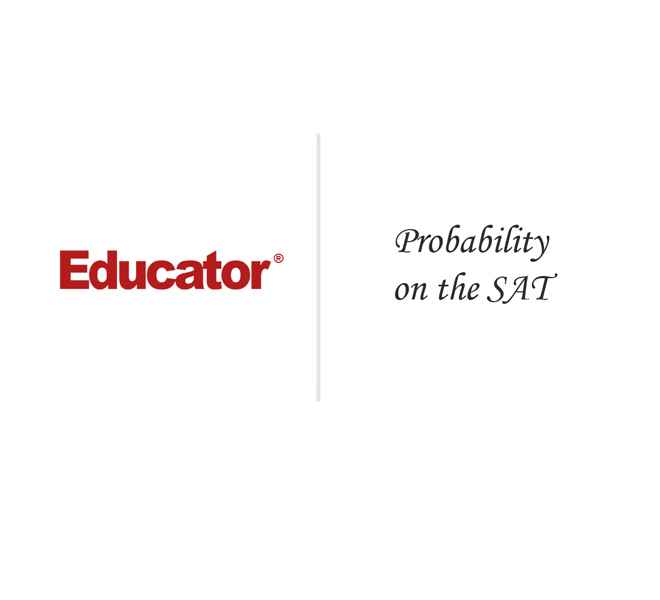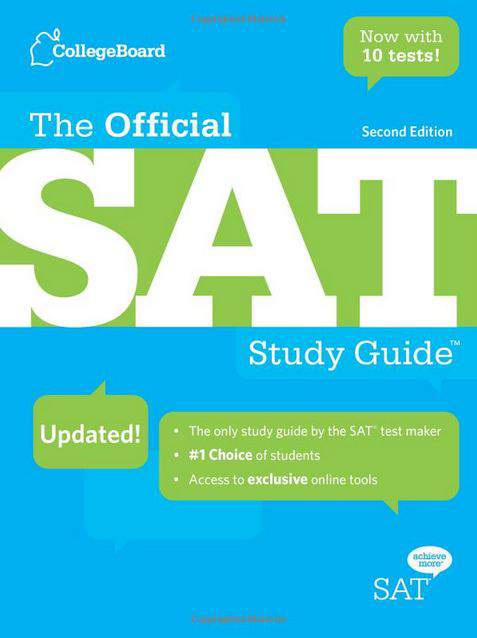

Charlotte Vilkus
Probability on the SAT
Slide Duration:Table of Contents
Section 1: Basic Math
SAT Properties of Integers
6m 40s
- Intro0:00
- How Properties of Integers are Tested0:12
- Learn by Example: Prime Factors4:38
Fractions on the SAT
8m 50s
- Intro0:00
- How Fractions are Tested on the SAT0:11
- Learn by Example: Evaluation with Fractions3:16
- Learn by Example: Word Problem with Fractions6:32
Percent on the SAT
22m 16s
- Intro0:00
- How the SAT Tests Percent0:10
- Percent Increase and Decrease3:24
- Percent More Than, Percent Less Than7:53
- Learn by Example: Percent Translation9:29
- Learn by Example: Percent More Than13:38
- Learn by Example: Dealing with Tax and Tip16:31
Number Lines on the SAT
8m 31s
- Intro0:00
- How Number Lines are Tested on the SAT0:08
- How to Solve SAT Number Line Problems0:54
- Learn by Example: Number Line Coordinates4:52
- Learn by Example: Representing and Inequality with a Number Line6:33
Exponents on the SAT
9m 32s
- Intro0:00
- How Exponents are Tested on the SAT0:09
- Consider Plugging in on Exponent Problems0:21
- Learn by Example: Exponents in Simultaneous Equations1:03
- Learn by Example: Exponent Analysis6:15
Absolute Value on the SAT
12m 36s
- Intro0:00
- How Absolute Value is Tested on the SAT0:11
- Learn by Example: Absolute Value3:07
- Learn by Example: Absolute Value and Inequalities7:09
Section 2: Proportions, Rates and Variations
Proportions on the SAT
11m 15s
- Intro0:00
- How Proportions are Tested on the SAT0:11
- Learn by Example: Map Scaling2:07
- Learn by Example: Medium to Hard Unit Conversion4:40
- Learn by Example: Where the SAT Really Tries to Trip You Up on Units8:24
Rates on the SAT
12m 39s
- Intro0:00
- How Rates are Tested on the SAT0:12
- Learn by Example: Videos Processed per Hour2:50
- Learn by Example: Multiple Rates7:27
Variations on the SAT
7m 59s
- Intro0:00
- How Variations are Tested on the SAT0:13
- Learn by Example: Direct Variation2:22
- Learn by Example: Variations4:12
- Learn by Example: Inverse Variation7:04
Section 3: Geometry
Area and Perimeter on the SAT
16m 59s
- Intro0:00
- SAT Problems on Area and Perimeter0:11
- Learn by Example: Perimeter of a Quarter Circle2:50
- Learn by Example: Area of the Unshaded Region4:26
- Learn by Example: Perimeter of a Square Inscribed in a Circle10:03
- Learn by Example: Using Pythagorean to Get Side Lengths13:23
Angles on the SAT
12m 11s
- Intro0:00
- How Angles are Tested on the SAT0:11
- What You Need to Know About Angles1:13
- Lean by Example: Angles (1)2:48
- Lean by Example: Angles (2)5:45
Triangles on the SAT
15m 25s
- Intro0:00
- What Sort of Triangles Will I see on the SAT?0:11
- Learn by Example: Triangle Basics5:09
- Learn by Example: Special Triangles10:14
- Learn by Example: Triangles with other Shapes12:12
Quadrilaterals on the SAT
13m 34s
- Intro0:00
- How Quadrilaterals are Tested on the SAT0:12
- Learn by Example: Squares1:50
- Learn by Example: Rectangle with Triangles6:29
- Learn by Example: Angles in a Quadrilateral Problem11:17
Circles on the SAT
16m 40s
- Intro0:00
- How Circles are Tested on the SAT0:11
- But Don't Bother with Any of This1:40
- How to Deal with Sections of a Circle1:55
- College Board Expects Mistakes Here4:04
- Circumference=Perimeter4:47
- Learn by Example: How Circle Problems Are Presented5:18
- Three Tangential Circles5:48
- Learn by Example: Concentric Circles8:56
- Learn by Example: Shaded Area with Combination Circles and Squares11:53
Section 4: Graphing
SAT Coordinate Geometry
14m 38s
- Intro0:00
- How the SAT Test Coordinate Geometry0:17
- Learn by Example: Midpoint and Distance3:08
- Distance Example: the Length of the Square5:39
- Example: Figures in the Coordinate Plane9:34
SAT Translation
10m 6s
- Intro0:00
- How the SAT Tests Graph Translation0:11
- Shifting the Graph in the Y: f(x)+a1:01
- Shifting the Graph in the X: f(x+a)1:50
- Multiplying the Graph af(x)2:59
- Multiplying the Graph f(ax)5:07
- How the SAT Tests Rotations and Reflections6:19
- Learn by Example: Rotations and Reflections7:52
Lines on the SAT
6m 15s
- Intro0:00
- How Lines are Tested on the SAT0:09
- Learn by Example: Finding the Intercept1:48
- Learn by Example: Perpendicular Lines3:42
Line Slope on the SAT
10m 46s
- Intro0:00
- How Line Slope is Tested on the SAT0:10
- Definition of Slope0:25
- Slope Equation1:12
- Classifying Slopes: Steep, Flat, Negative1:50
- Determining the Slope in Problems3:41
- Learn by Example: Line Slope (I)4:43
- Learn by Example: Line Slope (2)8:04
Section 5: Advanced Algebra
SAT Quadratic Equations
6m 46s
- Intro0:00
- How the SAT Tests Quadratic Equations0:11
- Required Knowledge for Quadratic Equations2:52
- Learn by Example: Quadratic Equations5:02
Expressions on the SAT
10m 20s
- Intro0:00
- How Expression are Tested on the SAT0:10
- Learn by Example: Expression Evaluation--Signed Numbers and Exponents1:17
- Learn by Example: Expression Evaluation of Arithmetic Overload6:16
Systems of Equations
28m 57s
- Intro0:00
- The Basics: Systems of Equations0:19
- Equations with Infinite Solutions0:44
- Number of Equations Should Match the Number of Unknowns2:41
- Manipulation and Combination4:34
- Manipulation and Combination: Really?7:23
- Manipulation and Combination: Coefficients10:41
- Manipulation and Combination: Steps13:50
- Substitution15:49
- Which Method Should Be Used?20:13
- Oh No, Three Equations?22:58
- Three Equation Example24:22
Inequalities on the SAT
13m 8s
- Intro0:00
- How Inequalities are Tested on the SAT0:11
- What to Know: Inequalities3:12
- Learn by Example: Solving an Inequality for a Variable7:12
- Learn by Example: Inequalities with Parameters9:02
Special Functions on the SAT
8m 16s
- Intro0:00
- 'Special Functions' on the SAT0:09
- Treating Special Functions like General Function Evaluation *Same Idea (Implies)1:24
- Learn by Example: Special Functions (1)3:40
- Learn by Example Special Functions: (2)4:40
Section 5: Statistics, Combinations and Probability
Averages on the SAT
10m 20s
- Intro0:00
- How Averages are Tested on the SAT0:10
- Important Quantities: Average, Sum and Number of Values0:36
- Rearranging the Average Equation to be of Maximum Use1:36
- Learn by Example: Averages (1)3:16
- Learn by Example: Averages (2)7:17
Median and Mode on the SAT
8m 31s
- Intro0:00
- How the SAT Test Median and Mode0:32
- Learn by Example: Using a Table to find the Median1:46
- Learn by Example: Finding the Median with an Unknown4:41
- Learn by Example: Mode6:35
Data Analysis on the SAT
18m
- Intro0:00
- How Data Analysis is Tested on the SAT0:11
- Tables1:16
- Using Table Totals2:08
- Pie Charts3:50
- Pie Charts Examples5:56
- Creating Pie Charts7:00
- Bar Graphs9:35
- Comparing Pie Charts and Bar Graphs11:22
- Scatter Plot Graphs12:45
- Example of a Scatter Plot13:48
- Line Graphs15:12
- Line Chart Example15:32
Probability on the SAT
9m 37s
- Introduction0:00
- How the SAT Tests Probability0:10
- Probability Definition0:54
- Probability of A or B occurring1:56
- Probability of A and B both occurring3:16
- Learn by Example: Probability (1)4:12
- Learn by Example: Probability (2)6:07
Combinations and Permutations on the SAT
10m 10s
- Intro0:00
- How Combinations and Permutations are Tested on the SAT0:14
- Using 'Blank Space' Representors1:32
- Learn by Example: Combinations2:44
- Writing Out the Possibilities3:53
- Learn by Example: Permutations5:14
- Writing Out the Possibilities7:04
Logical Reasoning on the SAT
9m 18s
- Intro0:00
- How Logical Reasoning is Tested on the SAT0:11
- Learn by Example: Logic Questions and Using Differences0:54
- Learn by Example: Logic Questions with Inequalities5:32
Loading...
This is a quick preview of the lesson. For full access, please Log In or Sign up.
For more information, please see full course syllabus of SAT: Mathematics
For more information, please see full course syllabus of SAT: Mathematics
SAT: Mathematics Probability on the SAT
Lecture Description
In this lesson our professor Charlotte Vilkus keys you in on what you can expect from Probability Problems on the SAT and goes over probability examples reflective of what you should expect on the SAT
Bookmark & Share
Embed
Share this knowledge with your friends!
Copy & Paste this embed code into your website’s HTML
Please ensure that your website editor is in text mode when you paste the code.(In Wordpress, the mode button is on the top right corner.)
×
Since this lesson is not free, only the preview will appear on your website.
- - Allow users to view the embedded video in full-size.
Next Lecture
Previous Lecture














































0 answers
Post by Jeffrey Tao on October 26, 2013
This is more of an important point for other viewers than a question. In the case of the crayons, the probability of picking in the AND case is 1/10 x 1/10 ONLY if after one crayon is picked, it is put back into the box before the second pick. Otherwise, if the crayon is left out, the probability is 1/10 x 1/NINE because if the crayon isn't put back after the first draw, then during the second time picking the crayon, there will be only nine crayons, thus it is 1/NINE x 1/10.